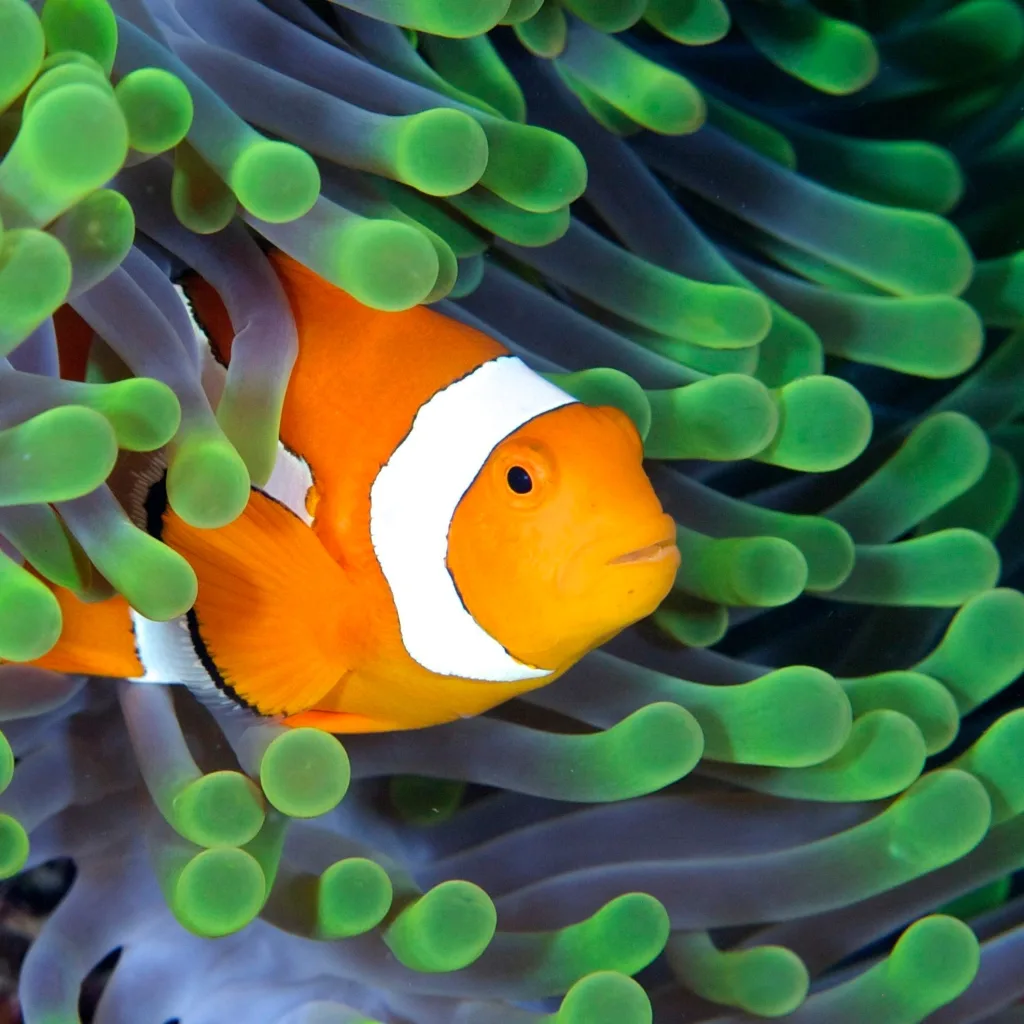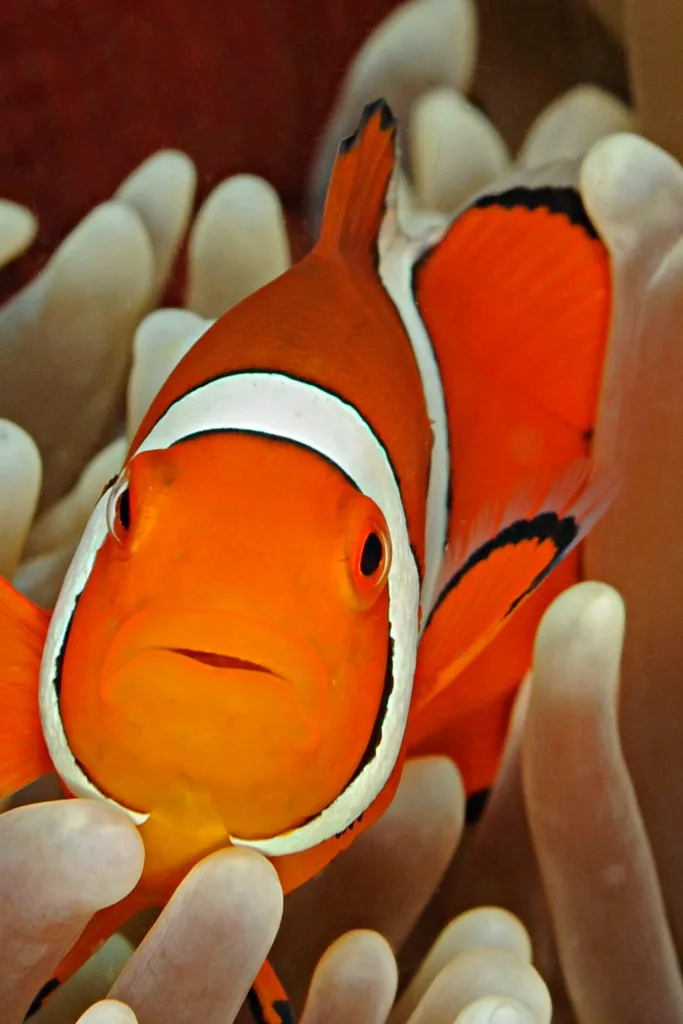Clownfish are an interesting species. Not only are they brightly colored, but they are also capable of something truly remarkable: gender change. That’s right – clownfish can change their gender!
Clownfish start off life as males and live in small groups with a dominant male and female and up to four juvenile males. But what hapens when the female dies? The dominant male changes sex to become the new female of the group and one of the juveniles becomes the new dominant male. This process is known as sequential hermaphroditism, and it is driven by transcriptional responses at the brain level.
The process starts within 30 days after the death of the original female, with differential expression being detected in the gonads up to 50 days later. This change is permanent, so once a male clownfish turns into a female, there is no going back.
So why would clownfish go through this process? Well, it’s all about survival. Clownfish live in small groups that inhabit a single anemone – if there’s no female present, then it’s essential for another fish to become one in order for eggs to be fertilized and babies to be born.
This fascinating ability has made clownfish a popular choice for aquarium owners all over the world. With proper care and maintenance, these little fish can provide years of enjoyment with their unique characteristics and personality.
So if you’re looking for a pet fish that will keep you enthralled for years to come, consider getting a clownfish! They may be small, but they sure have big personalities – thanks to their ability to change genders!
Can Clownfish Change Their Gender?
No, clownfish cannot change from female to male. Clownfish are born male and can only change from male to female. A group of clownfish typically consists of a dominant male and female, as well as 0-4 juvenile males. When the dominant female in the group dies, the dominant male will undergo a physiological change and become the new dominant female, while one of the juveniles will become the new dominant male. This is known as sequential hermaphroditism and is a common trait among many species of fish.

How Long Does It Take For a Clown Fish To Change Gender?
Clownfish undergo sex change within the span of 30-50 days, depending on the species. This process begins when the dominant female in a group dies or is removed, and one of the remaining males becomes a female. The main transcriptional response driving this change at the brain level is typically completed within 30 days after removal of the original female, while differential expression in the gonads can still be detected up to 50 days later. Once complete, males become immature females and are ready to take on a reproductive role.
The Reasons Behind the Gender Transformation of Clownfish
Clownfish are protandrous hermaphrodites, meaning they start life as a male and then later transition to female. This change is triggered by the death of the breeding female in the group, which causes a shift in the social hierarchy. The dominant male then undergoes a physiological transformation, becoming a female, an irreversible process that allows for the continuation of the species. The newly formed female will mate with the subordinate male to ensure that young are produced and the population continues to thrive.
Gender Transformation in Clownfish
Sequential hermaphroditism is the term used when clownfish change gender. It is a type of protogyny, whih occurs in many species living in coral reefs. During this process, individuals can switch from female to male or vice-versa. In clownfish specifically, the gender shift is triggered by the dominant fish in the group. When the dominant female dies, the next largest fish in the group will become a male and take its place as the dominant fish. The other fish will then move up one rank in social order and change their gender accordingly. This provides an advantage to clownfish by ensuring that there is always a breeding pair present in a given group.
Can a Single Clownfish Change Sex to Female?
Yes, a single clownfish will become female if it is not kept in an environment with other clownfish. This is because clownfish are protandrous hermaphrodites, meaning they are born male and can switch to female if the social situation dictates. In the wild, groups of clownfish are composed of a dominant female and several smaller males. The presence of the dominant female suppresses the development of the males into females. In situations whee there is only one fish (or if all other members of the group die), there is no social interaction to suppress its development and it will tend towards becoming female.

Is Marlin, Nemo’s Father, Female?
Yes, Nemo’s dad is a female. All clownfish are born as undifferentiated hermaphrodites, meaning that they have both male and female reproductive organs. When their female mate dies, the male clownfish will transform into a female to take over the role of caring for the clutch of eggs. This is what happened in Nemo’s case; when his mother was eaten by a barracuda, his father transformed into a female in order to care for the eggs until they hatched.
Marine Fish That Can Change Gender
Many species of marine fish can change gender, a process known as protogyny. This includes the kobudai, a type of wrasse, as well as many species of parrotfish and reef fish. In protogynous species, some individuals will start out as males, some will switch from female to male at a certain point in their lives, and others will remain female for the full duration of their lives. This switching typically occurs when the current alpha male dies or is removed from the group. The new alpha male is usually a female that has switched genders to assume the role.
The Consequences of a Dead Clownfish
If a clownfish dies, its mate will undergo a process of gender transformation to take on the role of protecting the territory previously occupied by its species. This process requires extensive hormonal changes, resulting in the mate changing from male to female. The newly transformed female clownfish will then assume the duties of finding food and defending eggs against predators. Additionally, they will provide care for any other members of their species in the area.
The Impact of the Death of a Dominant Female Clownfish
When the dominant female clownfish dies, the remaining dominant male in the group will undergo a physiological transformation and become a female. This process is known as sequential hermaphroditism, and it occurs becase all clownfish are born as males. As part of this process, the male’s body will produce hormones that cause the reproductive organs to be reorganized in order for it to become a functional female. The new female clownfish will assume the role of dominant fish in the group, reproducing with any other males present. Clownfish are omnivorous animals that feed on plankton, mollusks, algae and small crustaceans.
Lifespan of Clownfish
Clownfish are hardy creatures and can live up to 30 years depending on the species. In captivity, they typically live between 3-5 years when given proper care. When living in the wild, clownfish can live up to 6-10 years on average. To ensure a long and happy life for your clownfish, provide them with a healthy diet, suitable living conditions (water temperature, pH levels and salinity), regular water changes and regular health checks by a qualified professional. With the right kind of care, clownfish can even outlive their typical life expectancy!
Can Fish Change Gender?
Yes, male fish can change gender. This phenomenon is known as sequential hermaphroditism, and it has been identified in over 500 species of fish. Clownfish are one of the most well-known examples. They start life as males, then transition to females after reaching a certain size or age. Other species, such as gobies, can switch back and forth between genders multiple times throughout their lives depending on social environment or other factors. In some cases of sequential hermaphroditism, the opposite transition is also observed – kobudai start out as females and eventually turn into males.
Animals That Can Be Both Sexes
Animals that can be both sexes, commonly referred to as hermaphrodites, are found throughout the animal kingdom. The most common examples are invertebrates such as earthworms, bryozoans, trematodes, snails and slugs. Earthworms possess both male and female reproductive organs within their bodies and can self-fertilize. Bryozoans are moss-like animals that reproduce by propagating through asexual budding or by sexual fusion of two organisms. Trematodes are small parasitic flatworms that have separate sexes but can also reproduce asexually through fragmentation and cell division. Snails and slugs are hermaphroditic gastropods that usually fertilize each other during mating, although they can also self-fertilize in the absence of a mate. Other invertebrate animals that exhibit hermaphroditism include barnacles, where the adults may have either female or male reproductive organs or both. Some fish species such as clownfish are also known to be hermaphroditic; thee fish usually start life as males and later transition to female sex as they mature.
Are Clown Fish Always Male at Birth?
Yes, all clownfish are born male. They possess the ability to change their sex, but will only do so if they need to become the dominant female in a group. This change is permanent and cannot be reversed.
Conclusion
In conclusion, clownfish are capable of changing their gender from male to female. This change is known as sequential hermaphroditism and occurs when the dominant female in a group dies, prompting the dominant male to become the new female. The process is irreversible and requires approximately 30 days for the brain level transcriptional response to be completed and 50 days for the gonads to reflect the new sex. Clownfish are fascinating animals that demonstrate a unique ability to adapt to their environment.
